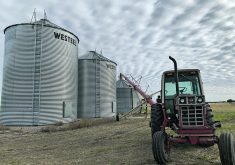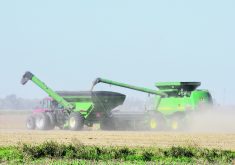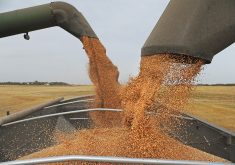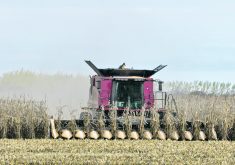Saskatchewan
Despite some recent rains, 91 percent of the 2012 crop was in the ground by June 4, placing Saskatchewan growers ahead of the five-year average for this time of year and outpacing last year when 79 percent of the crop was seeded.
Across the province, most spring cereals, canola, mustard and pulse crops are in the pre-emergent and emerging stages, while fall cereals are in the jointed to shot-blade stage.
South
Southeastern producers continue to make progress following rains the previous week — the Tantallon area has already received 242 millimetres — with 89 percent of the crop in the ground by the end of last week.
Read Also

Europe holds promise for Canadian lentils
Pulse Canada is trying to help boost lentil consumption in Europe, which is already the fourth largest market.
Seeding is further along in the southwest, with topsoil conditions across the south largely rated as adequate, although as much as 55 percent of cropland has surplus moisture in the southwest crop district. Nine percent of acres in the southeast are expected to remain unseeded due to excess moisture.
In the areas hit hardest by rain, there are some reports of flood damage and emergence issues in canola and flax fields. Additionally, flea beetles have emerged in canola crops, while high winds have delayed some spraying operations.
Central
Seeding in east-central Saskatchewan continues to lag behind the rest of the province, but producers have made significant gains, moving up to 84 percent complete from 59 percent the previous week. Seven percent of acres in the region are expected to remain unseeded due to excess moisture.
There were reports of some frost damage in low-lying field areas and emergence issues in canola and flax fields following rains, although high winds are helping to dry the soil.
In west-central Saskatchewan, producers are nearing 100 percent completion and, with warm temperatures, are seeing positive crop development.
North
Northern producers are finishing seeding and only a small fraction of the 2012 crop remains to be sown.
Several areas saw rain over the period, but in most cases, totals didn’t amount to more than 10 mm, with the majority of topsoil moisture on cropland rated as adequate.
Rains have delayed weed control and canola and flax emergence in some areas, but excess topsoil moisture isn’t a problem in most areas. The majority of crop damage in the northwestern areas is due to flea beetles.
Overall, crops are emerging well and have benefited from recent warm weather.
Alberta
SOUTH
A large storm cell pummelled the southern part of the province from the United States border to Calgary. It dumped between 30 and 100 mm of rain on June 5.
Hail damage has been reported in the Taber, Enchant, Vauxhall and Retlaw areas north of Lethbridge.
One confirmed tornado dropped down near Taber and caused some damage to farm buildings and trees.
Crop damage is still being assessed on canola, dry beans and fababeans.
Considerable erosion occurred in tilled fields while those in minimum till systems fared better.
Spring cereals are currently entering the tillering stage, with canola and peas in the cotyledon to three leaf stage. Winter cereals are performing well and are in mid-stem elongation. Spraying has started for fungal diseases in winter wheat.
CENTRAL
Seeding is complete and about three-quarters of crops have emerged. The region experienced continuing light showers and cool temperatures.
Spring cereals are in the two to three leaf stage with canola and field peas in the cotyledon to three leaf stages. Winter cereals are entering the stem elongation stage.
Spraying is getting underway although insects like flea beetles have not been an issue.
Soil moisture ratings have declined slightly but most are rated as good to excellent.
Hay and pastures are also in good condition.
NORTHEAST AND NORTHWEST
Seeding is almost complete in the northeastern regions and about half the seeded crops have emerged but need heat to get a good spurt of growth. Spraying has started.
Soil moisture ratings and pasture conditions have improved significantly thanks to timely rains.
Northwestern districts are further ahead with seeding complete and most crops above ground. Spraying is underway.
Flea beetle populations are higher in the northwest with infestations rated as moderate.
Soil moisture ratings and pasture conditions have improved significantly thanks to timely rains.
PEACE
Seeding is nearing completion. The central portion of the region received 50 to 75 mm of rain. It caused some excessive moisture, but the southern region remains dry for the second year in a row.
Spraying has started but there are no significant insect pests at this time.
Manitoba
Most of Manitoba can anticipate above-average production in this crop year assuming conditions remain good, FarmLink Marketing reported last week.
The regular crop report is not available this week.
EASTERN
Crops in eastern Manitoba are advancing well, reports FarmLink Marketing in its June 7 prairie crop conditions report.
Moisture conditions vary, ranging from “nearly ideal” south of Winnipeg to excessive in the north and east.
Winter wheat and fall rye are starting to head out, while spraying is underway on spring cereals.
Frost affected some corn crops early in June, possibly setting them back by a week or two, says FarmLink. Soybeans are average, but should improve with warmer weather.
CENTRAL
Dryness in some parts of central Manitoba is affecting winter wheat, although most of the region has fairly good moisture conditions.
Warmer conditions are needed to improve development of later-seeded crops, says FarmLink.
WESTERN
Western Manitoba crops have received timely moisture and warmer temperatures. In the northwest corner, farmers have reported replanting canola and have found cutworms.
Spraying is underway, although high winds have slowed activity somewhat in the western region.














